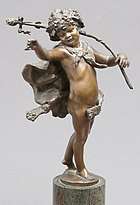Franz Iffland
Franz Iffland (1862–1935) was a German sculptor and painter who worked during the late 19th and early 20th century. He was born in 1862 in Berlin, Kingdom of Prussia. The majority of his sculptures were influenced by the jugendstil movement but late in his career, beginning in the mid-1920s, he produced a number of art deco sculptures. Iffland died in Berlin, Nazi Germany in 1935.
Franz Iffland | |
|---|---|
An art deco bronze sculpture of a nude dancer by Franz Iffland (c. 1924) | |
| Born | 1862 |
| Died | 1935 (aged 72–73) |
| Nationality | German |
| Education | Königliche akademische Hochschule für die Bildenden Künste |
| Known for | Sculpture |
Notable work | The Archer[1] Columbine[2] |
| Movement | Art nouveau Art deco |
Early career
Iffland received his formal training at the Königliche akademische Hochschule für die Bildenden Künste. He was primarily known for his small bronze statues of young children and bust sculptures of young women. He was a painter as well, however sculpture dominated his output during his career.
Artistic style

The majority of his work was produced during the art nouveau or "jugendstil" period from 1887 to 1910, but late in his career he produced a number of art deco bronzes of nude women and genre statues of ordinary working people such as blacksmiths[3] and farmers. One of Iffland's contemporaries, who worked during the same period as Iffland in Berlin and did similar types of sculptures, was Otto Schmidt-Hofer.
Iffland also executed a few animal sculptures and sporting figure statues of archers, javelin throwers, and polo players. He presented his work in bronze at the Große Berliner Kunstaustellung (Great Berlin Art Exhibition) in 1893.[4]
Iffland typically applied dark brown patinas to his smaller bronzes but often elected to apply more elaborate patination to larger works intended for exhibition in art shows. A number of his more important statues featured gilt patinas in real 24 carat gold. Iffland's chryséléphantine pieces tend to bring the best prices at auction. One such example was Columbine which fetched $8,372 in a sale on 7 November 2007 at Christie's, London, South Kensington.[2]
Iffland employed a number of foundries to cast his bronzes, including the Kraas foundry in Berlin. Many of his sculptures bear the Kraas foundry mark.[1]
Death and legacy
Iffland died in 1935 in Berlin, Germany. He is remembered as one of Germany's finest sculptors during the late 19th and early 20th century.
Gallery
References
- "'The Archer', a Franz Iffland Patinated Bronze Figure". christies.com. Retrieved 15 June 2015.
- "'Columbine', a Bronze and Ivory Figure". christies.com. Retrieved 28 January 2016.
- "Franz Iffland (German 1862–1935)". jennmaur.com. Retrieved 15 June 2015.
- "Franz Iffland (Listed)". altekunst-vienna.com. Retrieved 15 June 2015.
- Berman, Harold (1974). Bronzes, Sculptors & Founders – Signatures (Vol. 2 ed.). Chicago, Illinois: Abage Publishers. p. 477.
Literature
Franz Iffland. Ulrich Thieme; Felix Becker – Allgemeines Lexikon der Bildenden Künstler von der Antike bis zur Gegenwart. Band 18, E. A. Seemann, Leipzig 1925, S. 549.